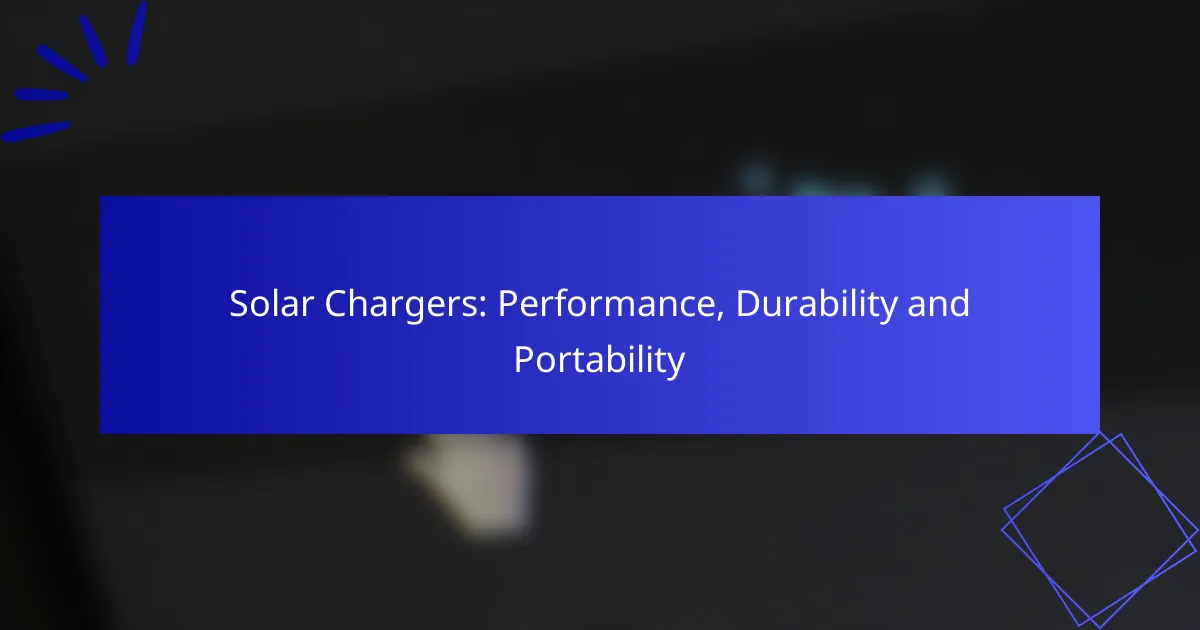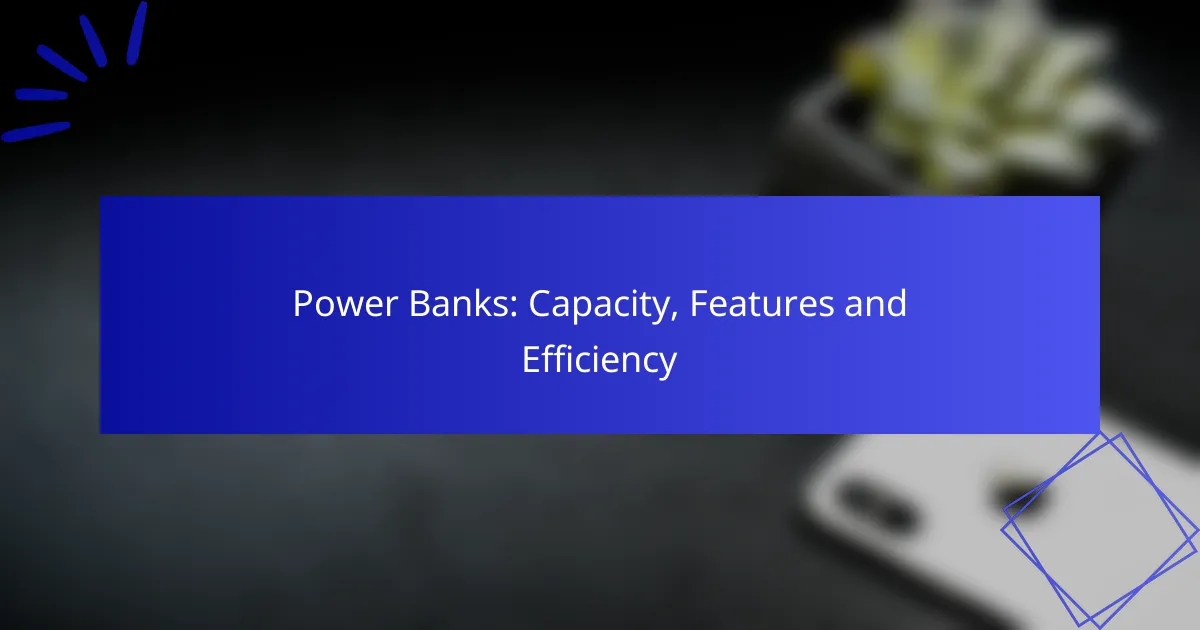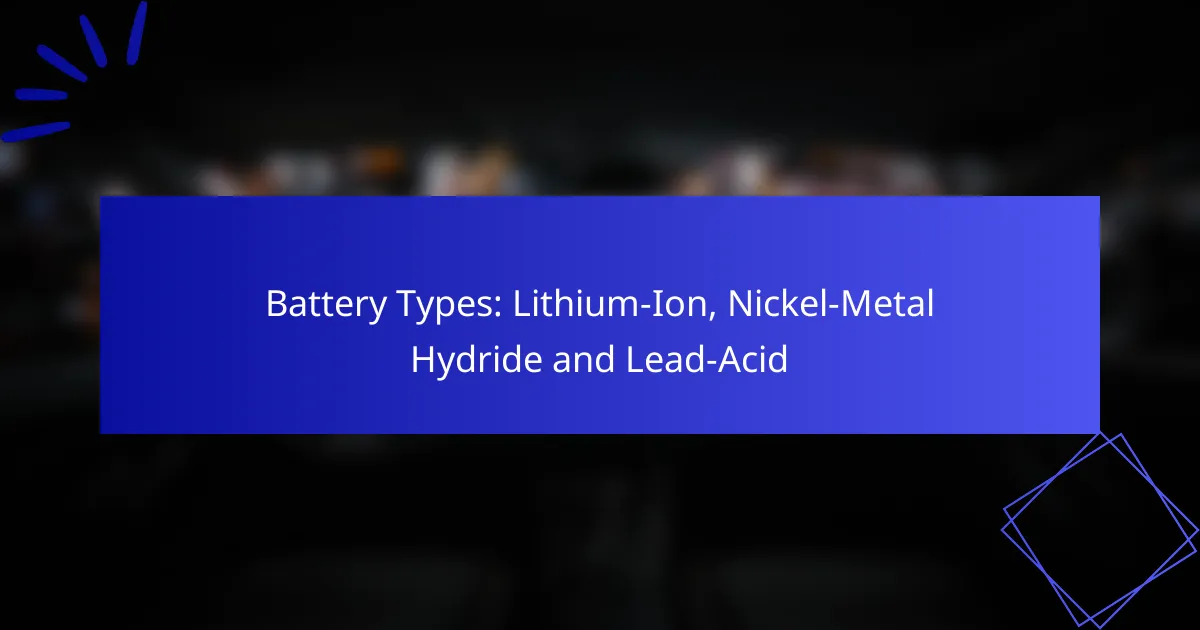Solar chargers offer a sustainable way to harness energy, but their performance can vary significantly based on environmental factors like sunlight intensity and weather conditions. Durability is crucial for reliable power in harsh environments, while portability ensures ease of use during outdoor activities. Selecting the right solar charger involves considering these aspects to meet individual needs effectively.
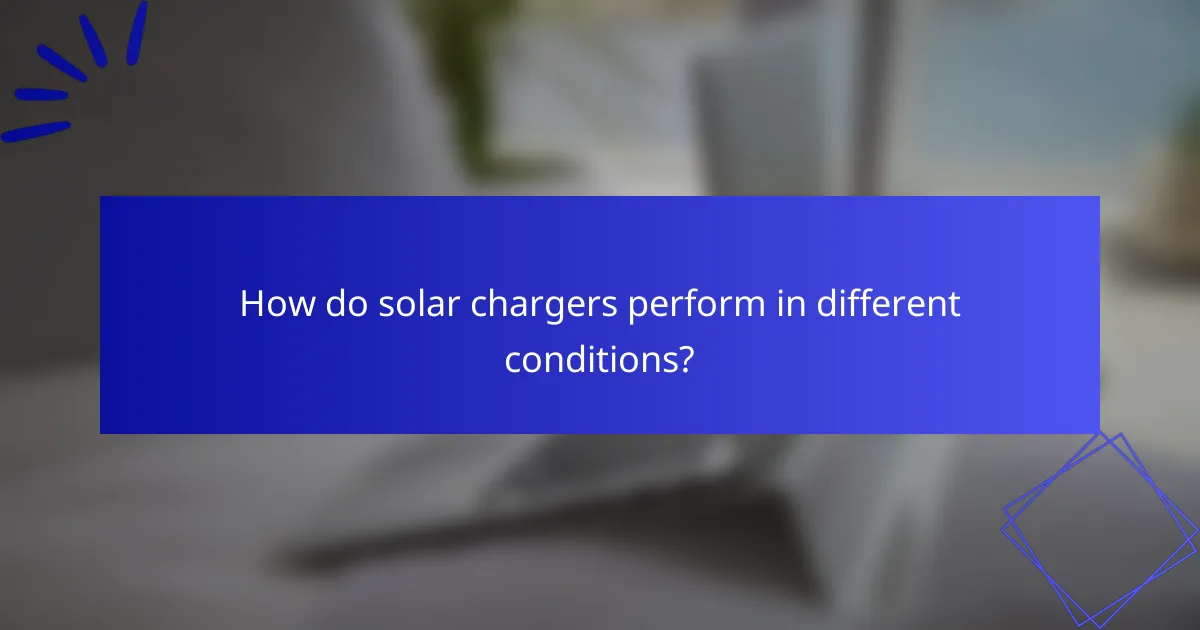
How do solar chargers perform in different conditions?
Solar chargers perform variably depending on environmental conditions such as sunlight intensity, cloud cover, temperature, and humidity. Understanding these factors can help users select the right solar charger for their needs.
Performance in direct sunlight
In direct sunlight, solar chargers operate at their peak efficiency, converting a significant portion of solar energy into usable power. Most models can achieve output levels close to their rated capacity, often between 15-25 watts, depending on the size and technology used.
For optimal performance, position the solar panel to face the sun directly and avoid any obstructions that could cast shadows. Regularly cleaning the panel surface can also enhance energy absorption.
Performance in cloudy weather
Cloudy weather significantly reduces the efficiency of solar chargers, often resulting in output that is only 10-30% of their rated capacity. While they can still generate some power, the charging process will be much slower.
To maximize efficiency during overcast conditions, choose solar chargers with higher sensitivity or those designed to perform better in low-light situations. Additionally, using a battery bank can help store energy when conditions improve.
Performance in cold temperatures
Cold temperatures can affect the performance of solar chargers, but they can still function effectively. Solar panels typically operate better in cooler conditions, as high temperatures can reduce efficiency.
However, users should be cautious of snow or ice accumulation on the panels, which can block sunlight. Regular maintenance and positioning the charger at an angle can help mitigate these issues.
Performance in humid environments
Humidity can impact solar charger performance by promoting the growth of mold or mildew on the panel surface, which can obstruct sunlight. While the chargers can still function, their efficiency may decrease if not properly maintained.
To ensure optimal performance in humid conditions, regularly clean the panels and store them in a dry location when not in use. Consider using chargers with protective coatings to enhance durability against moisture.
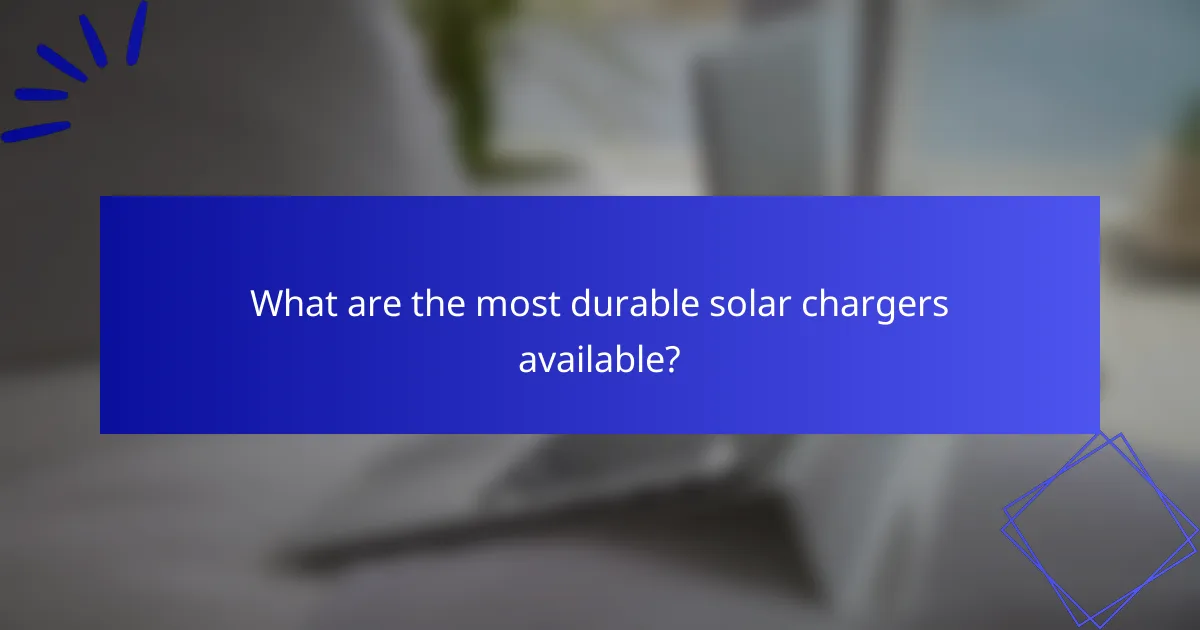
What are the most durable solar chargers available?
The most durable solar chargers are designed to withstand harsh environmental conditions while providing reliable power. Key factors include robust materials, weather resistance, and efficient energy conversion.
Renogy 100W Monocrystalline Solar Panel
The Renogy 100W Monocrystalline Solar Panel is known for its high efficiency and durability. It features a corrosion-resistant aluminum frame and can withstand heavy wind and snow loads, making it suitable for various outdoor conditions.
This panel operates effectively in low-light environments, which enhances its usability during cloudy days. Its compact size allows for easy transport, while its robust construction ensures longevity, making it a solid investment for outdoor enthusiasts.
Goal Zero Nomad 20
The Goal Zero Nomad 20 is a portable solar charger that excels in durability and ease of use. It is made with rugged materials and is water-resistant, ensuring it can handle outdoor adventures without damage.
This charger is equipped with a built-in kickstand for optimal sun exposure, and it can charge devices directly or store energy in a power bank. Its lightweight design and foldable feature make it highly portable, ideal for camping or hiking trips.
Anker 21W Dual USB Solar Charger
The Anker 21W Dual USB Solar Charger is designed for portability and efficiency. It features a durable fabric and a weather-resistant design, making it suitable for various outdoor activities.
This charger can power two devices simultaneously, thanks to its dual USB ports. Its compact, foldable design makes it easy to carry, while its high conversion efficiency ensures quick charging even in less-than-ideal sunlight conditions.
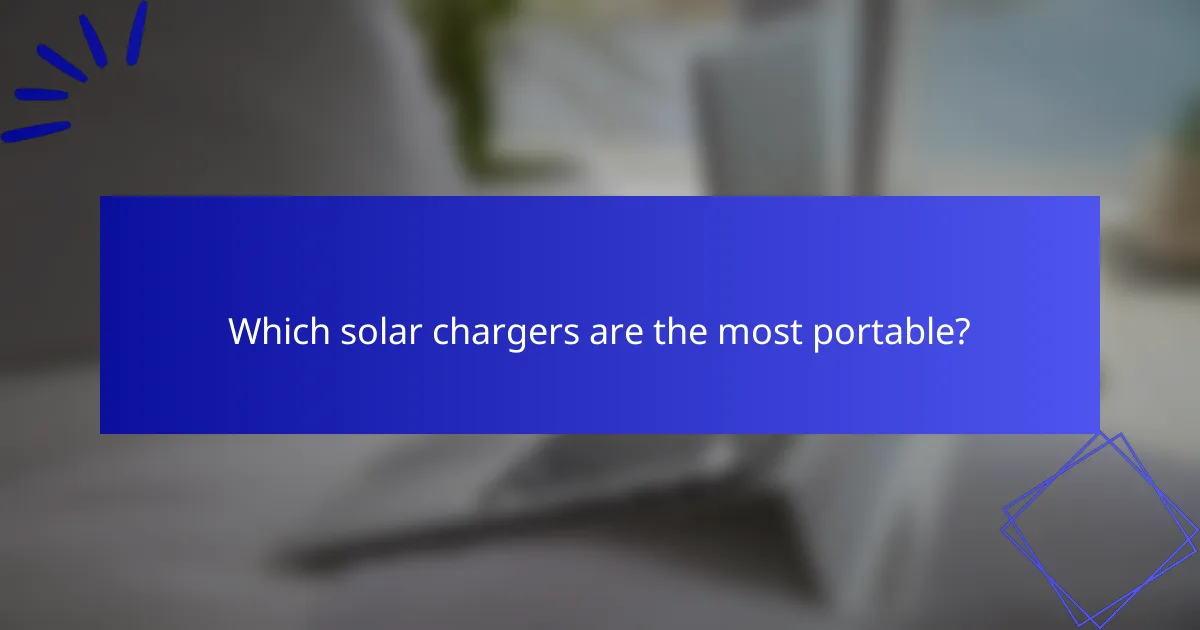
Which solar chargers are the most portable?
The most portable solar chargers are lightweight, compact, and easy to carry, making them ideal for outdoor activities. Look for models that fold or roll up for convenience and have a high power-to-weight ratio.
RAVPower 24W Solar Charger
The RAVPower 24W Solar Charger is known for its lightweight design and efficient solar panels. Weighing around 1.5 pounds, it easily fits into a backpack and can charge multiple devices simultaneously with its dual USB ports.
This charger performs well in various lighting conditions, making it suitable for camping or hiking trips. Its durable fabric and weather-resistant design ensure longevity, but it’s essential to keep it clean for optimal performance.
BigBlue 28W Solar Charger
The BigBlue 28W Solar Charger offers a slightly higher power output while remaining portable at about 1.5 pounds. It features a unique smart charging technology that optimizes charging speed based on the device connected.
This model includes three USB ports, allowing you to charge multiple devices at once. Its foldable design makes it easy to store, but ensure you protect it from extreme weather conditions to maintain its durability.
SolarSaga 100W Portable Solar Panel
The SolarSaga 100W Portable Solar Panel is a more substantial option, weighing around 9 pounds, making it less portable than smaller models but still manageable for car camping. It provides a significant power output, ideal for charging larger devices or multiple gadgets quickly.
This panel features a sturdy build and is designed for outdoor use, with a foldable structure for easier transport. While it’s more powerful, consider the trade-off in weight and size when planning your outdoor activities.

What factors should you consider when choosing a solar charger?
When selecting a solar charger, consider charging speed, battery capacity, and weight and size. These factors significantly impact the charger’s efficiency, usability, and portability, making them essential for effective solar charging.
Charging speed
Charging speed refers to how quickly a solar charger can convert sunlight into usable energy. This is influenced by the solar panel’s efficiency and the amount of sunlight available. Typically, higher wattage panels charge devices faster, with many portable options offering charging times ranging from a few hours to a full day.
For practical use, look for chargers with at least 10W output for smartphones and 20W or more for tablets. Keep in mind that cloudy weather or limited sunlight can slow down the charging process significantly.
Battery capacity
Battery capacity is crucial as it determines how much energy the solar charger can store for later use. Measured in milliamp hours (mAh), a higher capacity means more stored energy, allowing you to charge devices multiple times before needing sunlight. For example, a 20,000mAh battery can typically charge a smartphone several times.
When choosing a solar charger, consider your power needs. If you plan to charge larger devices or multiple gadgets, opt for a charger with a capacity of at least 10,000mAh. This ensures you have sufficient energy for your devices during extended outdoor trips.
Weight and size
Weight and size are vital for portability, especially if you plan to carry the solar charger on hikes or camping trips. Lightweight and compact models are easier to transport but may sacrifice some battery capacity or charging speed. Aim for a balance between portability and performance.
For most outdoor activities, a solar charger weighing under 1 kg and folding to a compact size is ideal. This makes it easy to pack without adding significant bulk to your gear. Always check the dimensions and weight specifications before purchasing to ensure it meets your travel needs.
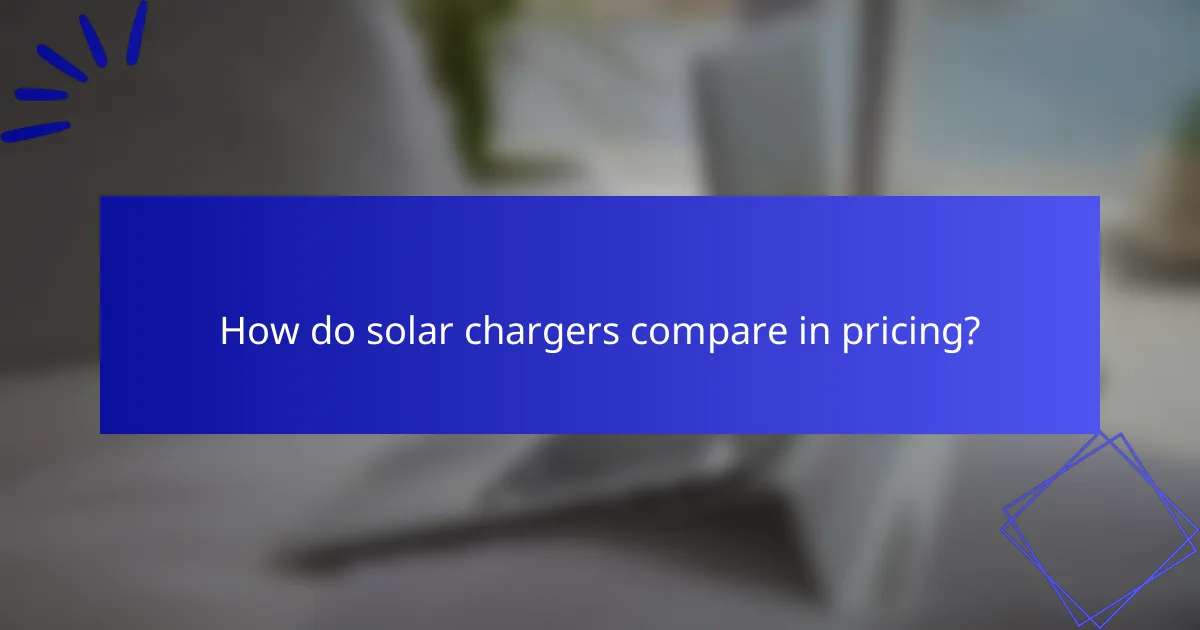
How do solar chargers compare in pricing?
Solar chargers vary widely in pricing based on their features, capacity, and brand. Generally, you can find options that cater to different budgets, from basic models to advanced units with higher efficiency and durability.
Budget options under $50
Budget solar chargers typically offer lower capacity and fewer features, making them suitable for casual use. These models often have a power output ranging from 5 to 10 watts, ideal for charging small devices like smartphones or portable speakers.
Examples include compact foldable panels that are lightweight and easy to carry. However, keep in mind that their performance may be affected by weather conditions and they may take longer to charge devices compared to pricier options.
Mid-range options between $50-$150
Mid-range solar chargers usually provide a balance of performance and durability, with power outputs between 10 to 30 watts. These chargers are more efficient and often come with additional features such as multiple USB ports and built-in batteries for energy storage.
These models are suitable for outdoor activities like camping or hiking, where reliable power is essential. Look for options with good reviews on durability and efficiency to ensure you make a wise investment.
High-end options over $150
High-end solar chargers are designed for serious users who need robust performance and features. With power outputs exceeding 30 watts, these chargers can handle multiple devices simultaneously and often include advanced technology for faster charging.
These models may also be built with rugged materials to withstand harsh conditions, making them ideal for extended outdoor adventures. When considering a high-end option, check for warranty and customer support to ensure long-term satisfaction.
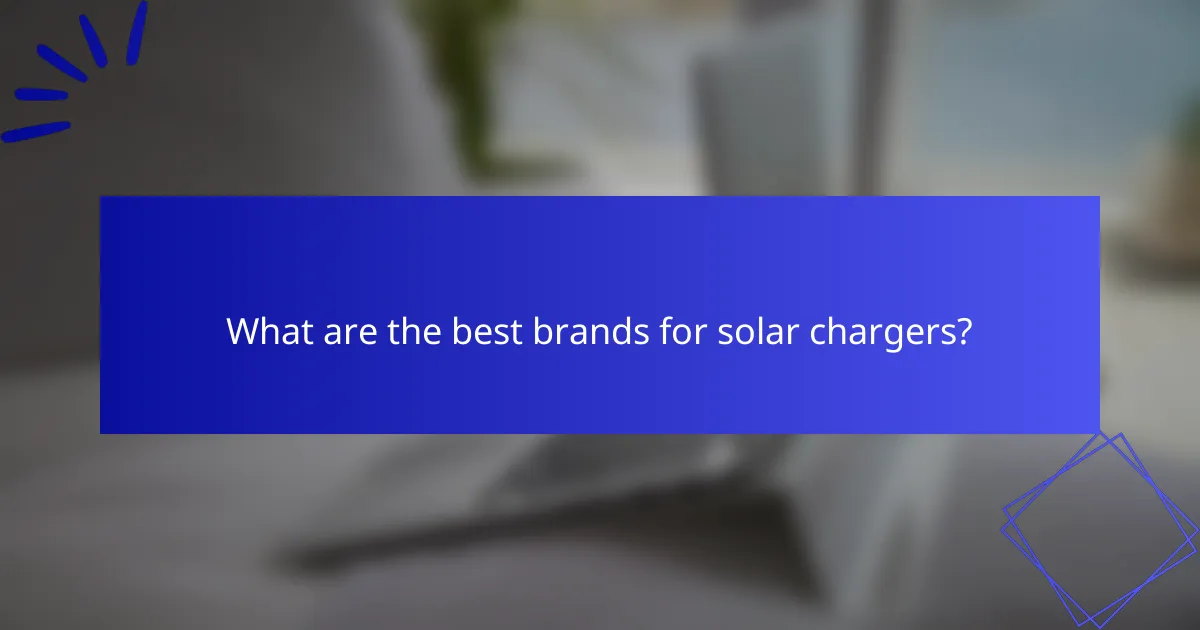
What are the best brands for solar chargers?
The best brands for solar chargers typically include Anker, Goal Zero, Renogy, and RAVPower. These companies are known for their reliable performance, durability, and portability, making them popular choices among outdoor enthusiasts and travelers.
Performance
Performance in solar chargers is primarily determined by their wattage output and efficiency in converting sunlight into usable energy. Most high-quality solar chargers range from 10 to 100 watts, with higher wattage allowing for faster charging of devices. Look for models with high conversion efficiency, ideally above 20%, to ensure optimal energy capture.
When assessing performance, consider the environment where you’ll use the charger. Factors like weather conditions, angle of sunlight, and shading can significantly impact charging speed. For example, a solar charger may perform well in direct sunlight but struggle in cloudy conditions.
Durability
Durability is crucial for solar chargers, especially for outdoor use. Look for models that are water-resistant or waterproof, as well as those made from rugged materials that can withstand drops and rough handling. Many reputable brands offer chargers with IP ratings, indicating their resistance to dust and water.
Additionally, check for features like reinforced corners and scratch-resistant surfaces. A durable solar charger can last several years, making it a worthwhile investment for frequent travelers or campers.
Portability
Portability is a key factor when choosing a solar charger, particularly for those who need to carry it on hikes or trips. Lightweight models that fold or roll up are often preferred, as they can easily fit into backpacks without adding significant weight. Look for chargers that weigh less than 2 kg for optimal convenience.
Consider the size when folded and the ease of setup. Some portable solar chargers come with built-in hooks or straps for easy attachment to backpacks or tents, allowing for hands-free charging while on the move.






